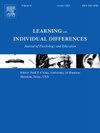What is creative in childhood writing? Computationally measured linguistic characteristics explain much of the variance in subjective human-rated creativity scores
IF 3.8
1区 心理学
Q1 PSYCHOLOGY, EDUCATIONAL
引用次数: 0
Abstract
The present study investigated the extent to which linguistic features of children's stories (analysed using automated techniques), predicted human-rated Creative Expressiveness and Logic scores (both assessed with the Consensual Assessment Technique). A sample of 160 children (Mage = 8.99 years, SD = 0.3) wrote stories based on three pictures. Eleven linguistic characteristics were measured: Length, Grammar, Originality, Controlled Lexical Diversity, Uncontrolled Lexical Diversity, Divergent Semantic Integration (DSI), Referential Cohesion, Narrativity, Syntactic Simplicity, Word Concreteness and Deep Cohesion. The results showed that 51 % of the variance in Creative Expressiveness was explained by Length, DSI, Originality, Grammar, and Controlled Lexical Diversity (sr2 = 0.01 to 0.14). In comparison, 28 % of the variance in Logic scores was accounted for by DSI, Grammar, Controlled Lexical Diversity, Syntactic Simplicity, and Narrativity (sr2 = 0.01 to 0.06). These findings offer insights for educational practices by identifying the linguistic characteristics relevant to children's creative writing as opposed to logical narration.
什么是儿童写作的创造性?计算测量的语言特点可以解释人类主观评定的创造力分数的大部分差异
本文章由计算机程序翻译,如有差异,请以英文原文为准。
求助全文
约1分钟内获得全文
求助全文
来源期刊

Learning and Individual Differences
PSYCHOLOGY, EDUCATIONAL-
CiteScore
6.60
自引率
2.80%
发文量
86
期刊介绍:
Learning and Individual Differences is a research journal devoted to publishing articles of individual differences as they relate to learning within an educational context. The Journal focuses on original empirical studies of high theoretical and methodological rigor that that make a substantial scientific contribution. Learning and Individual Differences publishes original research. Manuscripts should be no longer than 7500 words of primary text (not including tables, figures, references).
 求助内容:
求助内容: 应助结果提醒方式:
应助结果提醒方式:


